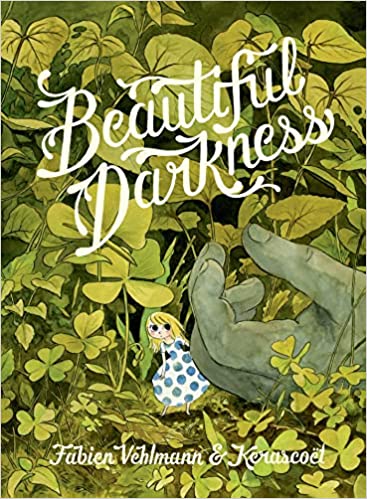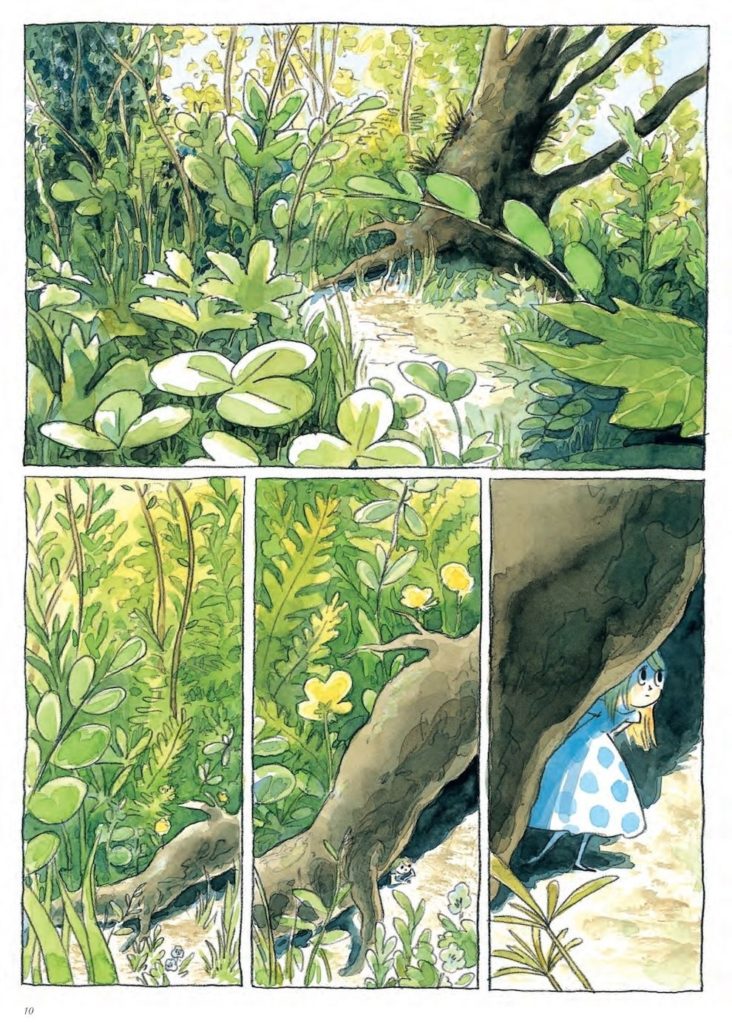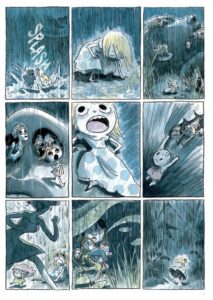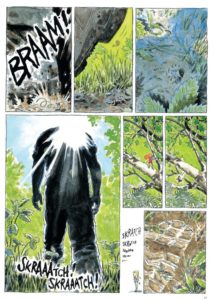 By FABIEN VEHLMANN, KERASCOËT (Drawn & Quarterly; 2009/15)
By FABIEN VEHLMANN, KERASCOËT (Drawn & Quarterly; 2009/15)
Translated Euro comics tend to be a pretty slow-moving field (I’m still surprised that so few people have taken notice of the English version of Philippe Druillet’s amazing THE NIGHT), but BEAUTIFUL DARKNESS, a French graphic novel scripted by Fabien Vehlmann and illustrated by “Kerascoët” (Marie Pommepuy and Sébastien Cosset), appears to have bucked the trend (it being a publication that, for once, I didn’t find out about until after most everybody else). A bestseller it wasn’t, but its 2015 English language debut by Drawn & Quarterly has drawn a fair amount of mainstream attention. Don’t be fooled, though: the vision on display here is a dark and unsettling one marked by blood, slime and decay. I strongly doubt you’ll be finding this book in too many school libraries.
I strongly doubt you’ll be finding this book in too many school libraries.
The story and watercolor artwork harken back to past eras, which seems quite deliberate on the parts of Vehlmann, Pommepuy and Cosset, who present this twisted story in the form of a fairy tale. The protagonists are a group of ant-sized children who find themselves stuck inside the nostrils of the corpse of a normal-sized girl. The miniature kids attempt to construct a civilization in the vegetation surrounding the body, a situation that recalls classic children’s stories ranging from PICCOLI to HONEY I SHRUNK THE KIDS, although Vehlmann, Pommepuy and Cosset have a much grander purpose in mind: their aim is nothing less than a LORD OF THE FLIES-esque allegory of western civilization.
 The leader of the miniature child-dynasty is a girl who christens herself Aurora (after the name written on a school journal belonging to the corpse). The society she heads quickly divides its citizenry into beautiful people and outcasts (in the form of a weird girl who takes shelter in the corpse’s hair, and feasts on the maggots that inevitably come to devour the body). Not that Aurora’s own place in this hierarchy is too secure, as a girl named Zelie, who possesses doll-like features and an impeccable fashion sense, gradually comes to usurp her. Aurora, however, cooks up a truly nasty way to enact revenge on Zelie and her minions, and reclaim her former status.
The leader of the miniature child-dynasty is a girl who christens herself Aurora (after the name written on a school journal belonging to the corpse). The society she heads quickly divides its citizenry into beautiful people and outcasts (in the form of a weird girl who takes shelter in the corpse’s hair, and feasts on the maggots that inevitably come to devour the body). Not that Aurora’s own place in this hierarchy is too secure, as a girl named Zelie, who possesses doll-like features and an impeccable fashion sense, gradually comes to usurp her. Aurora, however, cooks up a truly nasty way to enact revenge on Zelie and her minions, and reclaim her former status.
…the vision on display here is a dark and unsettling one marked by blood, slime and decay.
 Yes, this book’s metaphoric social study is an extremely ugly one, with cannibalism, disease, animal cruelty, mutilation and random death being among the outrages on display. The use of children as representatives for adult society, complete with marriages and royal processions, succeeds quite well in holding up a distorted mirror image to the nastier corners of our own non-miniature grown-up run world.
Yes, this book’s metaphoric social study is an extremely ugly one, with cannibalism, disease, animal cruelty, mutilation and random death being among the outrages on display. The use of children as representatives for adult society, complete with marriages and royal processions, succeeds quite well in holding up a distorted mirror image to the nastier corners of our own non-miniature grown-up run world.
 The book, alas, isn’t entirely praiseworthy. It has problems, starting with the fact that, it being a Euro comic, the storytelling is horrendous. There’s nothing in the way of narration or scene setting, leaving the reader to self-navigate a narrative that takes the form of disconnected sketches that seem closer to an anthology than a streamlined narrative. Characterization is another issue, as the only personages here who make any real impression are Aurora, Zelie and the maggot eater, with their fellows, who are frequently tasked with taking control of the story, essentially fading into the scenery. A further problem is with the dialogue, which ranges from expository flatness to cliched slang (with a character described as “A bit slow on the uptake”), which may be a fault of the English translation by Helge Dascher. Wherever the blame may lie, the lame wordage on display is a constant annoyance.
The book, alas, isn’t entirely praiseworthy. It has problems, starting with the fact that, it being a Euro comic, the storytelling is horrendous. There’s nothing in the way of narration or scene setting, leaving the reader to self-navigate a narrative that takes the form of disconnected sketches that seem closer to an anthology than a streamlined narrative. Characterization is another issue, as the only personages here who make any real impression are Aurora, Zelie and the maggot eater, with their fellows, who are frequently tasked with taking control of the story, essentially fading into the scenery. A further problem is with the dialogue, which ranges from expository flatness to cliched slang (with a character described as “A bit slow on the uptake”), which may be a fault of the English translation by Helge Dascher. Wherever the blame may lie, the lame wordage on display is a constant annoyance.
This book’s metaphoric social study is an extremely ugly one, with cannibalism, disease, animal cruelty, mutilation and random death being among the outrages on display.
